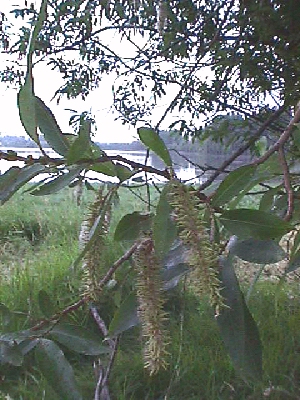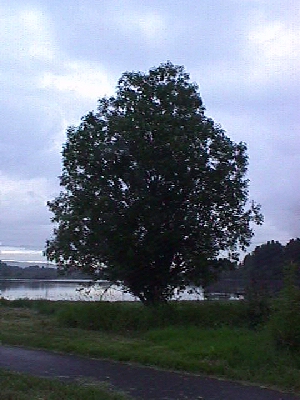

General Species Description
- Salix lucida
Leaves
- Leaves are alternate simple, and frequently long, narrow, and lance shaped (5-15cm) with very fine serrations. Older leaves are glossy. Leaf buds are red to orange and duckbill shaped. Floral bracts at base of stem are common on younger stems. Two or more glands at base of leaf distinguish this species.
Inflorescence/Flowers
- Males and female flowers are borne separately in long, thick catkins. Staminate catkins are 2-7 cm long and 1-1.5cm wide. Male flower has 4-8 stamens. Pistillate catkins are 3-12cm long. Capsules are a narrow pear-shape and from 4-8mm long.
Fruits
- Capsules are lanceoloid, up to 1/3 inch long, and smooth.
Habitat
- Along streams, lakes, ponds.
Range
- Salix lucida
Similar Species
- Salix lucida
Ecological Value
- Salix lucida is also a major source of food for beaver. Deer and elk may browse on the young shoots.
Human Value
- Like other Salix species that reproduce asexually from stems, Salix lucida is quick to colonize riparian areas and thus is commonly used in bioengineering and bank stabilization. Due to its height, Salix lucida is particularly beneficial in providing shade along small streams.
The fresh bark of all members of this genus contains salicin, which probably decomposes into salicylic acid (closely related to aspirin) in the human body. Native Americans use to chew on willow leaves as a mild pain killer.
References
- Cooke, S. S., ed. 1997. A Field Guide to the Common Wetland Plants of Western Washington & Northwest Oregon. Seattle Audubon Society and Washington Native Plant Society. Seattle Audubon Society, Seattle WA, 69pp.
- Hitchcock, C. L. and A. Cronquist. 1973. Flora of the Pacific Northwest. University of Washington Press, Seattle WA, 66pp.
- B. J. Guard. 1995.Wetland Plants of Oregon & Washington. Lone Star Publishing, Richmond WA, 187pp.
This page was created by: Jim Labbe, August 1998
Return to Northwest Oregon Wetland Plants Project